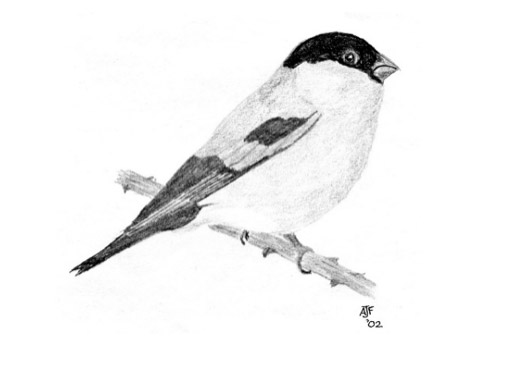Uncommon resident in serious decline.

Following increases in their numbers during the 1950s and 1960s Bullfinches are now in decline, this has been linked to hedgerow and scrub loss. In the winter and early spring, they feed on flower and fruit buds, and their ability to strip buds from fruit trees resulted in their persecution during the nineteenth century by fruit growers and gardeners. In Hertfordshire one of their local names is “budpricker.” Crossman (1902) recorded that Bullfinches were, “rather shot down in those districts where fruit is cultivated to any extent.”
The records from the 1960s, 1970s and 1980s are: a male in a Raleigh Close Garden on 5 July and 25 August 1965; 12 at Box Wood on 11 December 1965; 12 at Box Wood on 26 November 1967; an increase noted in Monks Wood in 1967 and 1968; up to six feeding on the seeds of Norway Maple (Acer platanoides) in a Lodge Way Garden in 1969; a pair and two young feeding in a Stevenage Garden on Honeysuckle berries August 1970; 12+ in the Hertford Road area on 3 December 1973; seven Fairview Road 24 January 1974; nine Monks Wood 2 February 1974; eight by Botany Bay 8 November 1974; nesting near the “Sanctuary” in Whomerly Wood 1974; seen at Astonbury on 10 April and 12 June 1976; 12 at Astonbury on 18 December 1977; six females at the, “Greenhouse Garden”, Astonbury on 22 January 1978; one at Astonbury on 2 June 1978; 42 ringed at Box Wood in 1978; Astonbury 1979, 1980 and 1986; between eight and 11 birds Watery Grove 9 to 15 January 1980; Box Wood 11 May 1985. During this period, they were quite common locally.
During the 1990s records came from: Ashtree Wood; Edmonds Drive; Lanterns Lane; Monks Wood; New Wood, Aston; Norton Green Tip; Watery Grove; Whomerly Wood and, Wiltshire Spring. A large flock of 24 was seen on 6 September 1996 at an unrecorded location, which is the most seen together at Stevenage.
Between 2000 and 2009 they were recorded from: Ashtree Wood; Astonbury; Aston End; Barham Road; Dene Lane; Fairlands Valley Lakes; Fishers Green; Gresley Way; Lanterns Lane; Long Lane, Aston; Monks Wood; New Park Lane, Aston; Norton Green Tip; Ridlins Mire; River Beane, Aston; Symonds Green; Tatlers Lane, Aston End and, Watery Grove.
Between 2010 and 2019 they were recorded from: Aston Allotments; Astonbury Wood; Aston Recreation Ground; Broadwater Lane; Chesfield; Dene Lane; Dyes Lane; Norton Green Tip; River Beane, Aston; Short Lane, Aston; Watery Grove and six on a Stevenage Garden feeder in 2017.
Since 2020, when there decline locally has become more noticeable, they have been recorded from: Aston Allotments; Aston End Road; Between Great Ashby and Chesfield; Fairlands Valley Lakes; Sheafgreen Lane, Aston End; Short Lane, Aston and Watery Grove.
The most recent record is of a male and female at Fairlands Valley Lakes on 18 March 2024.
They were confirmed as breeding from eight of Stevenage’s tetrads by both the 1973 and 1992 Breeding Atlases and, from two in the 2012 Atlas.
The Common Bird Census at Watery Grove recorded one breeding territory being held annually between 1972 and 1976. In 1977 and 1979 two territories were held. In the 1980’s single breeding territories were held in 1981, 1985, and 1987, and their presence was recorded in the 1984, 1988, and 1989 breeding seasons. In the 1990’s their presence was recorded in the 1991, 1992, 1993 and 1999 breeding seasons, single breeding territories held in 1994, 1995 and 1997, and two territories held in 1996.
The 2012 Winter Atlas confirmed their presence from seven of the tetrads covering Stevenage.
A bird ringed at Osterley, Middlesex in 1977 was, “controlled” at Stevenage on 30 June 1984. This is an unusual record as, the majority of, birds ringed in England are recorded within five kilometres of the ringing site.
